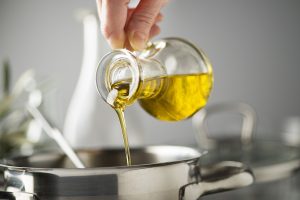When it comes to pottery and tableware, terms like ceramics, earthenware, porcelain and stoneware are often used interchangeably. But this can lead to some confusion in the world of cookery and homeware. However, these terms often refer to distinct materials and processes. In this article, we’ll be focusing on the differences between stoneware and ceramics.
This is to help you make a more informed decision about which material to use when. From roasting the perfect potato with your favourite vegetable oil, to serving a delicious salad drizzled in olive oil, here’s when to use stoneware, when to use ceramics and the differences between the two. We’ll also be touching on the pros and cons of each, for good measure:
What is ceramic?
Ceramic is a relatively broad term that encompasses any item made from non-metallic materials, which are typically clay. This clay is then shaped and hardened by heat. Ceramics are also glazed to help increase their non-porous quality, along with preventing discolouration and more.
Ceramics can be used in tableware, but you can also buy ceramic tiles, slabs and even bricks. Porcelain comes under the umbrella of ‘ceramics’. While stoneware is a type of ceramic, not all ceramics are stoneware; it’s important to note. There are different types of ceramics available on the market, including:
- Earthenware – usually fired at low temperatures, earthenware is often glazed and considered to be porous
- Stoneware – normally fired at higher temperatures, stoneware is often dense and durable in comparison to other types of ceramics
- Porcelain – fire at extremely high temperatures, porcelain is often vitrified and translucent
What is stoneware?
Stoneware is a specific type of ceramic known for its durability, semi-vitrified nature and density. It’s made from particular clays that can withstand high firing temperatures, typically between 1,100-1,300 degrees Celsius. There are numerous characteristics to stoneware that can help you distinguish between stoneware and ceramics, including:
- Being heavier than other ceramics and porcelain
- Non-porous, even without a glaze
- The material is dense and opaque
- It usually has a stone-like appearance and texture
- Stoneware is typically available in brown or grey colours, depending on the clay and firing method used
- They’re often used for functional pottery, like plates, bowls, mugs, baking dishes and more
What is the difference between ceramics & stoneware?
There are several differences between the two materials, despite the common misconception that they’re the same. We’re going to be detailing the differences between the two below, enabling you to make the right decision about which material to use for different applications and uses:
- Ceramics are defined as a broad category of fired clay, whereas stoneware is a type of high-fired ceramic
- Ceramics are fired at temperatures between 600-1,400 degrees Celsius, whereas stoneware is fired at temperatures between 1,100-1,300 degrees Celsius
- Ceramics can be both porous and non-porous, whereas stoneware is typically non-porous
- Ceramic durability will vary considerably depending on a multitude of factors, whereas stoneware is strong and often chip-resistant
- Ceramics are available in a wide range of colours, including bright, pale and dark tones, whereas stoneware is often only available in earthy or muted tones
- Ceramics are typically used for decoration or for everyday tableware, whereas stoneware can be used for cooking, baking and roasting, along with crockery
- Ceramics will often need glazing before use, whereas not all types of stoneware will require the same level of glazing
Stoneware vs. ceramics: What are their advantages & disadvantages?
With the differences between stoneware and ceramics cleared up, along with some general definitions of the two, we’re now going to be telling you what the pros and cons are of each material. This will further enable you to choose the right material for the job you have at hand. Here are the advantages and disadvantages of stoneware and ceramics:
What are the pros & cons of ceramics?
Pros:
- Versatile – can be used in everything from cookware to electronics
- Available in a range of colours and designs – choose between different colours, shapes, sizes, patterns and designs
- Heat resistance – can be used as cookware, ovenware and tableware
- Glazeable surface – ceramic is waterproof and non-porous, preventing stains and stubborn smells
- Inexpensive – some types of ceramics are very affordable
Cons:
- Brittle – ceramic can be thin and brittle, causing it to break easily
- Porous, if unglazed – this can lead to water absorption and the taking on of smells and stains
- Not always microwave safe – some glazes can become cracked when placed in microwaves or dishwashers, so always check the labels
What are the pros & cons of stoneware?
Pros:
- Durable – often ship-resistant, long-lasting and can handle everyday use
- Non-porous – even without a glaze, stoneware won’t absorb water
- Oven, microwave and dishwasher-safe – great for functional cookware, tableware and ovenware
- Rustic aesthetic – natural, earthy tones suit most styles and tastes, with a hand-crafted appeal
- Excellent heat retention – it helps to keep food warmer for longer
Cons:
- Heavy – can be bulky, making them hard to handle or even handwash
- Less fine surface – meaning it’s not ideal for delicate, intricate designs
- Can be costly – high-quality stoneware can be more expensive than basic ceramic products
- Prone to thermal shock – despite their durability, stoneware can still crack if moved quickly from hot to cold temperatures
- Limited colour range – tones tend to be more earthy, muted and generally less vibrant
How to choose between ceramics & stoneware
Now that you know what the differences and benefits of both ceramics and stoneware are, you’re better equipped to make a decision about which material would be best for specific applications. Are you looking to use these pieces for practical or ornamental use? Do you want to use them for formal table settings or traditional uses? There are many things you need to take into account before choosing between stoneware and ceramics, including:
- For everyday use – stoneware is ideal in this instance, thanks to its durability and strength
- For decorative or traditional use – ceramics would be sufficient for both of these applications, despite being the more fragile material when compared to stoneware
- For formal settings or delicate designs – both ceramics and stoneware would be ideal for these uses, as they come in a range of shapes, sizes, patterns and designs
Cater Oils is pleased to provide clients with fresh supplies of cooking oil, including olive oil, vegetable oil, sunflower oil, rapeseed oil and more. In addition, we can also collect waste cooking oil free of charge, in exchange for a credit note against our fresh cooking oil supplies or cash. If you would like further information about our cooking oil supplies or our used cooking oil collection service, then get in touch with a member of our friendly, professional team today – we’re always pleased to hear from you.
*image attributed to: Photo by <a href=”/photographer/photoscom-83818″>Photos.com</a> on <a href=”/”>Freeimages.com</a>






